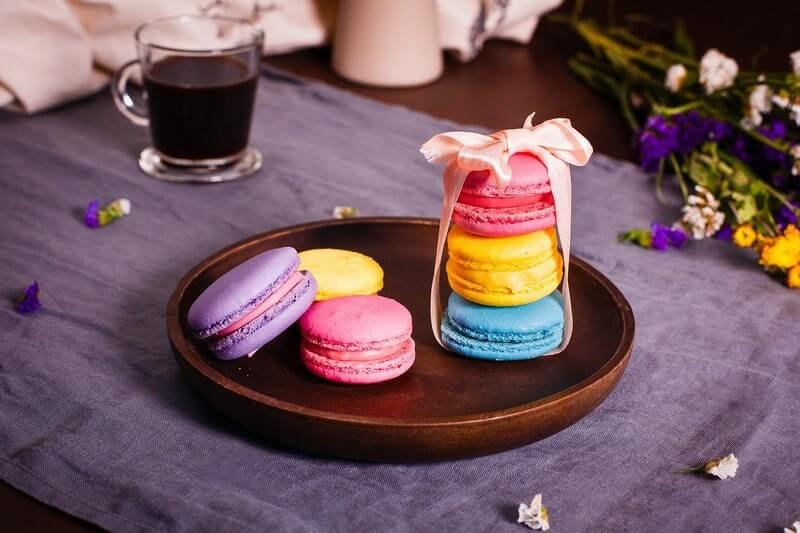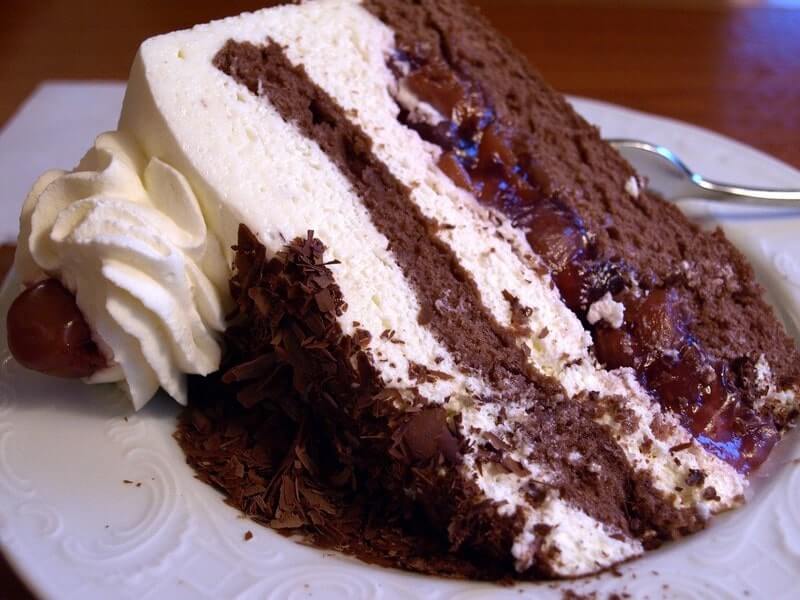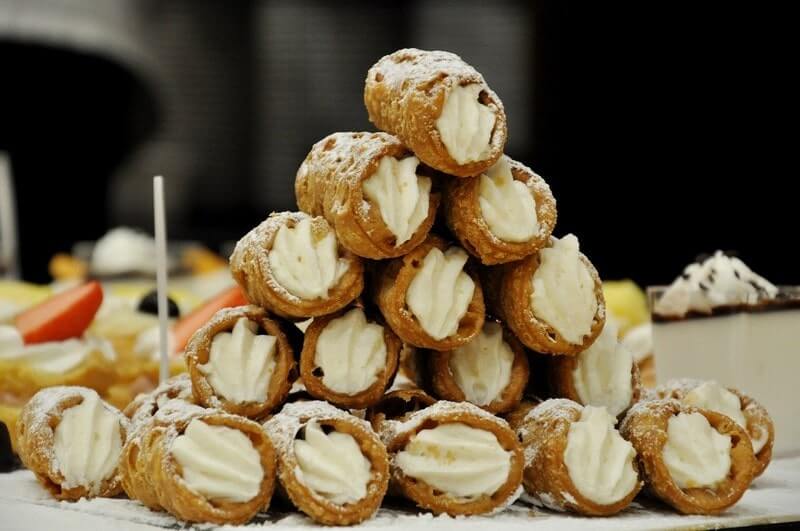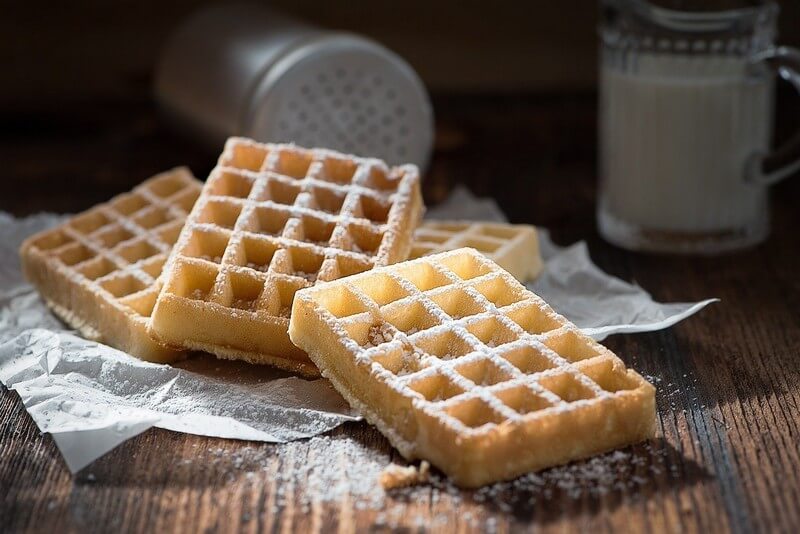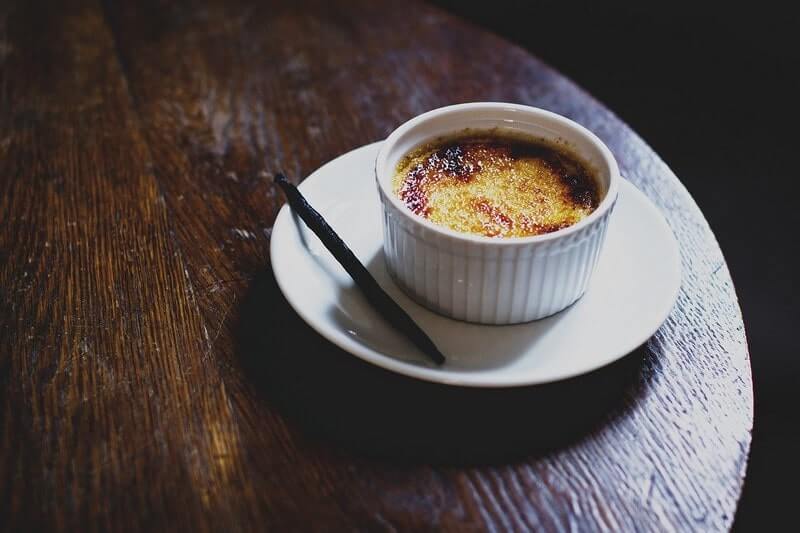Last Updated on February 15, 2024 by Soumya
Craving for European desserts? Here’s a list of my favorite European cheesecakes, pastries, and puddings that will absolutely melt your heart.
You will learn
- All about famous European desserts and the not-so famous, secret ones.
- Desserts from both Eastern Europe and Western Europe and where to try them.
You cannot end your Europe trip without biting into some of these European classics. So, next time you are visiting, do not forget to get a copy of this list.
The best part about these traditional European desserts is that you can easily make them at home too. I have linked to some really popular and easy recipes here for you to try.
20 Best European desserts that you need to try

Every time I embark on a new trip, I extensively research the must-have sweets for that country. And eat them when I get there. This fun, two-step process has led to an amazing collection of Must-Have European Desserts which I am sharing with you here.
Do not forget to try them whenever you are traveling to Europe next. You can also make them at home. Trying one of these European sweets definitely makes festive seasons even sweeter.
Please note: This post may contain affiliate links which means I may earn a commission if you make a purchase by clicking a link on this post. This will be at no additional cost to you. Affiliate links help me keep this website up and running. Thanks for your support!
Tiramisu | An Italian Classic

Italian Tiramisu – One of the most popular European desserts
Truth be told, I was a little confused about what to put at the top of my list. There are just so many delicious European sweet treats. But then I remembered my all-time favorite. Italy’s Classic Tiramisu. And the confusion was sorted.
Classic Italian Tiramisu is a fairly recent addition to the world’s culinary wonders. Unlike most other European desserts that I talk about here. It is believed to have originated in the late 1900s at a restaurant in Treviso, Northern Italy. And the movie Sleepless in Seattle kind of put Tiramisu on the American and World Dessert Map in the 1990s. (Remember that conversation between Sam and Jay??) Ever since the love for Tiramisu has become a cult in itself.
Tiramisu is a coffee-flavored Italian dessert. It is made out of ladyfingers soaked in coffee and then surrounded by sweetened whipped cream and a rich mascarpone.
That is decadence I will happily indulge in.
When in Italy, you must try Tiramisu at Le Beccherie in Treviso, the restaurant that claims to its birthplace. They have the Classic Tiramisu as well as a Wrong Tiramisu that sounds really interesting.
If you want to learn how to make Tiramisu, try this Pasta & Tiramisu Workshop in Rome. It has some rave reviews. Or try this easy 10-minute Tiramisu recipe at home.
Not keen about baking? No worries. You can also do a great Espresso, Gelato, and Tiramisu tour in Rome.
Macarons | The Elegant French Dessert

A signature French dessert – The Macarons
Macarons were most likely born in Italian convents and brought to France by Catherine de’ Medici in the early 1500s during her marriage to King Henry II of France. (You guessed it right. Catherine was the daughter of the rich and powerful Medici family of Florence.)
Macarons were called maccherone back then. They were humble-looking pastries made of almonds, egg whites, and sugar. These maccherones underwent a number of changes until the final version was invented in Paris.
Today, macarons are probably the most elegant and dainty of all French desserts. They are small round sandwiches made with meringue, almond flour, and buttercream/ganache/jam filling. Macarons are available in many flavors – raspberry, chocolate, lemon, or coffee. If you are a newbie, have a look at this Macaron Flavor Ranking by HuffPost.
Flavor rankings for a dessert! I told you. Macarons are huge!
When in Paris, try the macarons at Ladurée which still features the original recipe from the 20th century. Ladurée’s macarons became celebrities ever since they got featured in Sofia Coppola’s Marie Antoinette. Or try them at Pierre Hermé for their innovative flavors.
Bake your macarons in the heart of Paris with this amazing Macaron Bakery Class at Galeries Lafayette. Tasty also has this exceptionally-rated recipe if you want to try making macarons at home.
Pasteis de Nata | The King of Portuguese Desserts
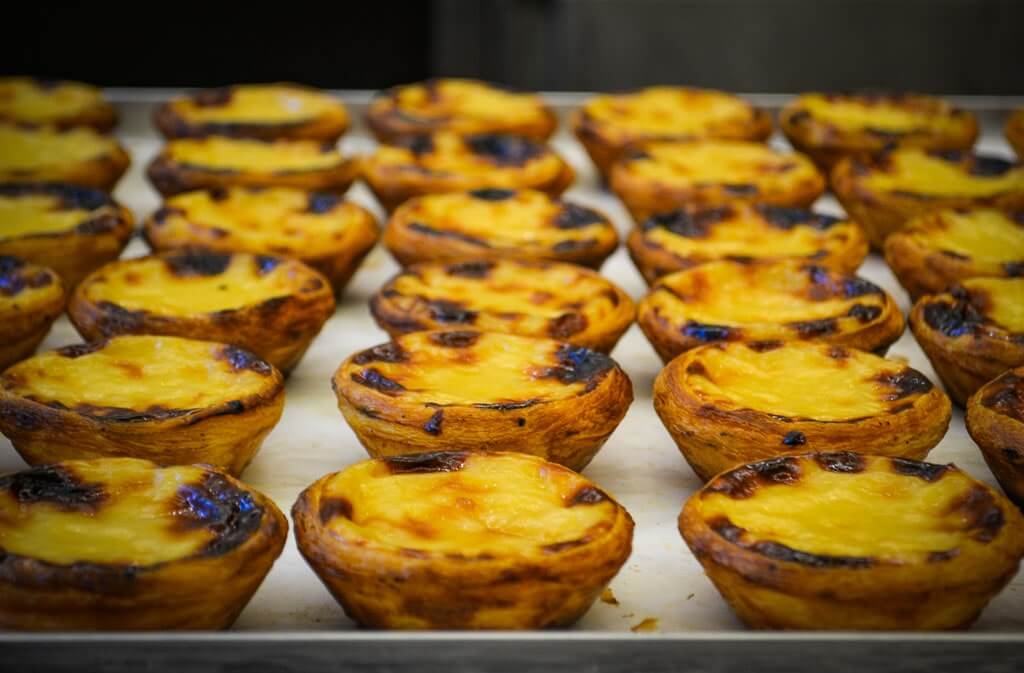
Ever since I returned from my trip to Portugal, I have been swooning over these delicious egg tarts. The Pasteis de Nata. Authentic Pasteis de Nata can be found all around the world in former Portuguese colonies. Try Macau and Brazil.
Pasteis de Nata, despite being a small, flaky custard, is the king of all Portuguese desserts. It was invented by the monks of the Jerónimos Monastery in Belém. You can still taste the original Pasteis de Nata at a cafe in Belem called the Pasteis de Belem. Other great options are Fabrica de Nata and Manteigaria which you can find in all big cities.
Keen to make it yourself? Try this recipe from Leite’s Culinaria. Though making it is a long process. I would rather order! But that’s me – more of a gorger than a baker!
Recommended: 9 Delicious Portuguese Desserts to try on your next Portugal trip
Madeleines | France’s Petite Butter Cakes

These petite European desserts can be found all over the globe
Madeleines are small butter cakes with a distinct shell shape. Madeleines hail from the Lorraine region of northeastern France. And like everything French, they are petite and dainty. And light. Perfect companions for an afternoon tea.
It is actually quite simple to make madeleines though the name might sound fancy. They require the most basic ingredients. Eggs, flour, sugar, and butter. Sometimes, lemon zest is used to give the madeleines a characteristic lemony flavor.
Lemony Madeleines are my favorites.
If you wish to taste these divine teacakes when traveling in Paris, try the madeleines at Patisserie Gilles Marchal. Their lemon glazed and salted caramel flavors are quite popular. If you want to make these petite European desserts at home, you can refer to this easy recipe on AllRecipes.
Semifreddo | Italy’s Semi-Frozen Mousse
Semifreddo is a half-frozen or semi-frozen Italian dessert. It is similar to the ice cream but not exactly the same. Semifreddo requires no churning as is common with ice cream.
It is more like a frozen mousse because a semifreddo is made by freezing a custard that is folded together with whipped cream. The custard is often layered with nuts or chocolate. Sounds gorgeous, doesn’t it?
I haven’t tried the Italian semifreddo yet. But it is very much on my bucket list for my next trip to Italy. If you know of the best places to have a bite of this exotic dessert, do let me know in the comments below. I would love to hear from you.
Appeltaart | Netherlands’ Apple Delight

Dutch Appeltaart – An apple lover’s delight
I am not a big lover of apple desserts but I know my husband is a die-hard fan. As are so many of you out there. So, here’s my first apple treat on the list. Appeltaart or the Appelgebak from the Netherlands.
This Dutch Apple Pie is an absolute must-eat when visiting the Netherlands. It is believed that the Appeltaart has been around for centuries. It was invented during the Middle Ages in Europe. Now, that’s quite long. Isn’t it?
Thick apple slices, raisins, and currants are used to bake an Appeltaart. And the flavor comes from cinnamon, rum, brandy, or lemon juice. The Dutch typically have their Appeltaarts with a dollop of whipped cream. It is a popular accompaniment to coffee.
One of the best places to try the Appeltaart is at the Cafe Winkel 43 in the de Jordaan quarters of Amsterdam. If you are keen on making the Appeltaart at home, try this recipe with great reviews.
Sernik | Poland’s Traditional Cheesecake

Polish cheesecake – One of the most delectable European desserts
The Sernik, Poland’s traditional cheesecake, is the Queen of all Polish desserts. It is a baked cheesecake that is made from twaróg – curd cheese, eggs, and sugar. The word Sernik actually comes from the Polish word “ser” for cheese.
Sernik is extremely popular among locals. People of Poland love to make the dessert at home as well as buy it from supermarkets. It is believed that the Sernik originated somewhere in the 17th century when King John III Sobieski brought the recipe with him after winning the Battle of Vienna against the Turks.
Churros | Spain’s Iconic Dessert & Snack
Churros are Spanish fried-dough pastries that are pretty popular in Spain and Portugal. Also in Central and South America. Origins of churros is unclear but interesting.
One theory suggests that churros were brought to Portugal by Portuguese sailors who came back from China in the medieval times. China does have a long, deep-fried dough albeit savory snack called Youtiao. There could be a connection there.
Making churros is easy. You just need some basic ingredients like flour, water, salt, and sugar. Refer to this easy recipe if you wish to make some without getting on a plane. And if you do get on that plane to Spain, make sure you eat your fill of churros at some of the best churro places in Spain.
Churros are best relished with creamy Spanish hot chocolate or coffee. They are often sprinkled with sugar. Or cinnamon especially in Mexico. I love it either way.
Black Forest Cake | Germany’s Delicious Cherry Cake
Now, this is special to my heart. I grew up with the black forest cake. It was part of all the birthday parties I attended as a child. Including mine. In fact, this was the first-ever European cake I tasted in my hometown Bhubaneswar, a small city in India.
Black Forest Cake is a delectable chocolate sponge cake that is supposed to have derived its name from the Black Forest region in Germany. The name could have come from a specialty liquor or a traditional hat of the region. Origins are still unclear.
A Black Forest Cake consists of multiple layers of chocolate cake with cherries and whipped cream in between. Once done, the cake is adorned with more whipped cream, cherries, and chocolate shavings.
This decadent cake is a popular dessert in Germany as well as in Austria, Switzerland, and parts of northern Italy. However, fame has taken the Black Forest Cake to everywhere around the world.
Eager to bake the Black Forest at home? Refer to this classic black forest cake recipe. It may not be very suitable for kids because the cherries are well-soaked in liquor. Do your research before you head out there.
Cannoli | A Sicilian Favorite
Cannoli are one of Sicily’s most popular desserts. They are believed to have originated in 9th century Palermo during the Arab rule. Similar sweets like the qanawāt are found in the Middle Eastern cuisine.
Cannoli were historically prepared as a sweet during the carnivals in Sicily. With time, they went on to become year-round favorites. And made a foray into mainland Italy. Mainland Italians still refer to cannoli as Cannoli Siciliani or the Sicilian cannoli.
This Sicilian favorite sweet treat is made of fried pastry dough shaped like a tube and filled with a rich, creamy paste made out of ricotta cheese, fruits, and pistachios. Have a look at this recipe if you want to make it at home.
When in Rome, you can try cannoli at I Dolci di Nonna Vincenza headed by Grandma Vicenza who makes delicious Sicilian desserts. Read Grandma Vicenza’s story here. When in Sicily, try a Palermo (yes! at the birthplace of cannoli) traditional food tour where you can taste Sicilian Cannoli, Sicilian Granita, and Sicilian Cassata. Sounds like a great deal!
Medovik | The Cake of The Czars

Medovik – A popular Eastern European Dessert
Medovik is a soft and spongy layer cake from Russia that is also popular in other countries of the former Soviet Union. One of the most unique components of the cake is honey which gives Medovik its characteristic taste and flavor.
It is believed that medovik took birth in the 1820s in the kitchens of a Russian Czar, Alexander I. One of his chefs created an innovative layered cake with honey and thick sour cream to impress the Czarina. The Empress, who otherwise hated honey, took an instant liking to this honey cake. And it became a hit among the public. Medovik continues to rule till date.
Today, you can find several flavors of medovik. While the honey biscuit remains constant, the filling can be made of whipped cream, condensed milk, custard, or buttercream.
Creating a medovik from scratch is a long and tedious process. But a satisfying one. Refer to this amazing recipe on Natasha’s Kitchen that takes close to 3 hours for an 8 layer cake.
Chocolate Souffle | France’s Most Complicated Dessert

Chocolate Souffle – One of the most prized European desserts
Souffle is one of the most classic French desserts. It is an egg-based dish that is made of egg yolks and whisked egg whites. It contains no wheat. Even though there are many different flavors like cheese and fruits, the chocolate souffle rules the roost.
This yummy light cake originated in 18th-century France. And ever since, it has been one of the cornerstones of the French cuisine – mostly in the dessert department. Well, souffles can be sweet or savory. The sweeter version is the more preferred one.
The pride of the French souffle lies in the fact that it is one of the most difficult desserts to make and master. It requires patience and extreme dedication.
A spoonful of souffle is airy like foam when done right.
The souffle is a French culinary marvel and is often reserved for special occasions like weddings and birthdays.
If you are looking forward to making the chocolate souffle at home, try this wonderful recipe by Chef John on All Recipes. And next time when you are in Paris, create some authentic souffle with this 2-Hour French Pastry Cooking Class. I am certainly going to do that.
Waffles | Belgium’s Gift to the World

Crispy and crunchy – waffles have won the world!
Waffles from Belgium. Ah, how could I forget them! Made from leavened dough patterned between two ironed plates, waffles are one of the most popular European desserts in the world today.
The waffle has an interesting history. Apparently, it has been around the since the time of the Greeks who made flat cakes between hot metal plates. Then, the French documented their very first waffle recipe during the middle ages. A waffle iron started making an appearance. Finally, Liège waffles, the most popular variety of Belgian waffles, are believed to have been invented in the 18th century.
Waffles are extremely popular across the world today. More so in the United States where they are eaten as a heavily loaded breakfast item. The American version is actually called the Belgian Waffle. In Belgium, you get Brussels waffles, Liège waffles, and Flemish waffles.
Keen to make your own waffles? Try this amazing waffle making workshop in Brussels.
Creme Brulee | France’s Delectable Burnt Cream

French Creme Brulee – Another well-known European dessert
Another French delight. The delectable creme brulee is a custard dessert topped with caramelized sugar. Or sugar burnt with a kitchen blowtorch. That is why creme brulee is also referred to as burnt cream.
But the taste is far from burnt. It is divine.
Origins of creme brulee are not certain. France, England, and Spain – all claim to have invented this famous dessert. However, the first printed recipe available to us is from a cookbook written by a cook from the Palace of Versailles. So, that seals the matter. And we consider creme brulee to be undeniably French.
Some of the best places to try creme brulee in Paris are Le Florimond and Le Coupe-Chou. If you want to make it at home, try this yummy recipe from Food Network.
Sfogliatella | The Monastery Dessert of Italy

Sfogliatella – An Italian dessert that looks like the croissant
Picture from Wikimedia Commons CC BY-SA 2.0
I had my first sfogliatella when I spent a day in Naples on my way to Pompeii. And it was heavenly! Definitely not my favorite Italian dessert. I am always biased towards the tiramisu. But the sfogliatella comes a close second. And here’s why you should try it too.
The sfogliatella is a shell-shaped puff pastry that resembles a stack of leaves. Its texture is almost similar to that of a croissant. Delicate and delicious, a sfogliatella holds a sweet filling. It can be ricotta, whipped cream, custard, or almond paste.
It is believed that the sfogliatella originated in the monastery of Santa Rosa in Salerno in the 17th century. Later, it appeared in the fancy pastry shops in Naples. For a taste of the authentic Santa Rosa sfogliatella, head to Naples’ most fashionable cafe, Pasticerria Andrea Pansa. And if you wish to make it at home, try this highly-rated sfogliatella recipe on Nonna Box.
Travesseiros | Sintra’s Pillowy Delight

Travesseiros at Casa Piriquita in Sintra
Unlike the Pasteis de Nata of Belem, the travesseiros of Sintra are much less known in the world outside of Portugal. Neither are they available in any of the former Portuguese colonies. But truth be told, these pillow-shaped Portuguese pastries can light up anybody’s day.
If you are visiting Lisbon, I am sure you will have plans to see the magical castles of Sintra. Do not forget to stop by the well-known Casa Piriquita cafe in Sintra’s historic center where the travesseiro was born. Because of its shape and origin, the travesseiro is often referred to as the Piriquita Pillow. Travesseiro means a pillow.
Travesseiros are puff pastries filled with a rich almond and egg yolk cream. They are flaky on the outside and soft and melt-in-the-mouth on the inside. The original recipe is still a closely guarded secret at Casa Piriquita. But you can always do a guided food tour. This Sintra food tour looks amazing complete with delicious travesseiros and Sintra’s hidden gems.
Blini | Russian Stuffed Pancakes
Next on our list is a simple but yummy Eastern European dessert from Russia, the Blini. The Blini is a stuffed pancake made of wheat. Both sweet and savory fillings are common. Sour cream, butter, caviar, and smoked fish are some of the popular ones. Making a true Russian blini is easy especially with this recipe.
Blini is widely eaten across Russia, Ukraine, and Belarus. In fact, it is one of the mainstays of the Maslenitsa Festival that is held at the end of winter every year in Russia. The Maslenitsa Festival has its origins in the Slavic culture when people considered the blini to be a symbol of the sun. Because of its round shape and yellow color.
Apfelstrudel | Austria’s National Dessert
Apple Strudel or Apfelstrudel is Austria’s favorite dessert. Quite evident when you see a recipe for the Viennese apple strudel on the official travel website of Austria. Apple strudel is enjoyed best when served with icing sugar and traditional Viennese coffee.
The strudel has some interesting history behind how it came into being. Apparently, Ottoman Empire’s baklava had a profound influence. But as we know it today, the Viennese strudel was created in 17th-century Austria during the Hapsburg Empire. Subsequently, it became popular in many parts of Central and Eastern Europe.
Austria’s apple strudel is an oblong flaky pastry with a delicious apple filling inside. Grated apples are often mixed with cinnamon, lemon zest, sugar, raisins, and breadcrumbs to make the filing.
I would love to try this iconic European dessert in Vienna. Wouldn’t you? Guess what, there is just the perfect tour for dessert fans like us. A Strudel Show with Tasting at Schönbrunn Palace where you can enjoy watching the making of strudel in the court bakery. I am so going to do this the next time I am there.
Mousse | France’s Foamy Dessert

Chocolate Mousse – One of my favorite European desserts
Mousse is an extremely light, fluffy sweet treat that originated sometime in 18th-century France. Mousses can be sweet or savory. Apparently, the savory version was invented first! That was news to me. Not a big fan of the savory ones but I could kill for the sweet kind.
Dessert mousses are often made with whipped egg whites and whipped cream. They are stiffly beaten to get the fluffy light consistency. The word mousse means foam or froth in French. And that is how the dessert gets its name.
Sweet mousses are often served cold. Sometimes frozen! They come in many flavors. But the most popular flavor is that of chocolate. Today, Chocolate Mousse has gained huge popularity around the world and is a common dish in all restaurant menus.
If you are in Paris and wish to do a mousse making class try this highly-rated Dessert & Chocolate Cooking Class with a Parisian Chef. You can make three amazing French desserts and one could be the Chocolate Mousse!
Gelato | World’s Most Popular Ice Cream

Gelato – The most ubiquitous of all European desserts
No. No. I have not forgotten everyone’s favorite ice cream. The Italian Gelato! Gelato has become so famous around the world today, sometimes we even forget that it originated in Italy. There are gelato shops at every corner. But eating the real gelato in its home country is an experience in itself.
Gelato originated in the 14th century when an Italian architect, Bernardo Buontalenti, presented the ice cream at the Medici court in Florence. (Seems the Medicis were responsible for the rise of a number of yummy European desserts!) Italians then took it to the rest of the world including Paris and the US.
Traditional flavors of the gelato include vanilla, chocolate, pistachio, and cream. A crucial difference between gelato and other ice creams is that it contains less fat (healthier) and less air (more intense flavors).
If you are already drooling, take an exceptionally-rated street food tour in Rome with a local guide where you can taste local foods such as cured meats, supplì, pizza, and gelato.
That’s a roundup of my 20 favorite European desserts.
Do you love desserts too? Which ones in Europe are your favorites? Do you love baking them at home? I would love to hear from you.



